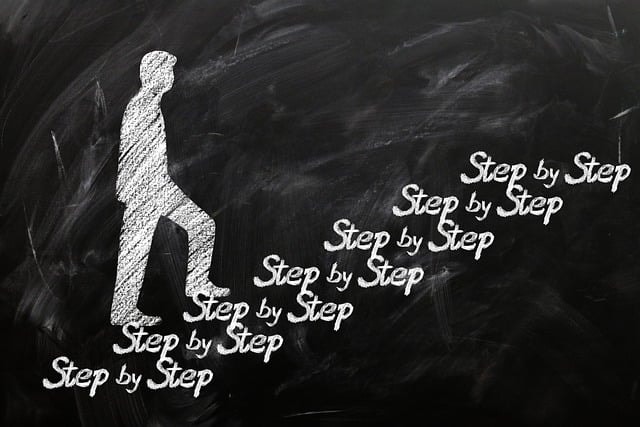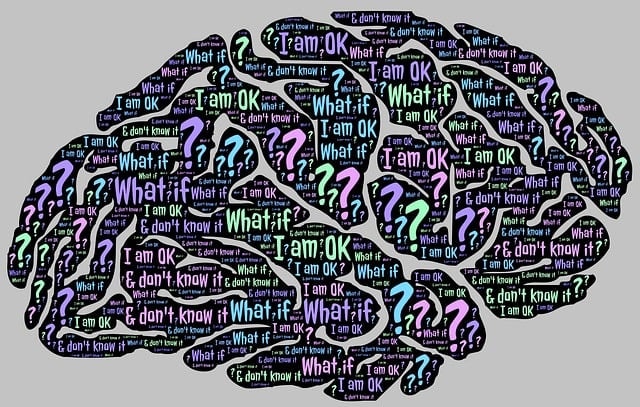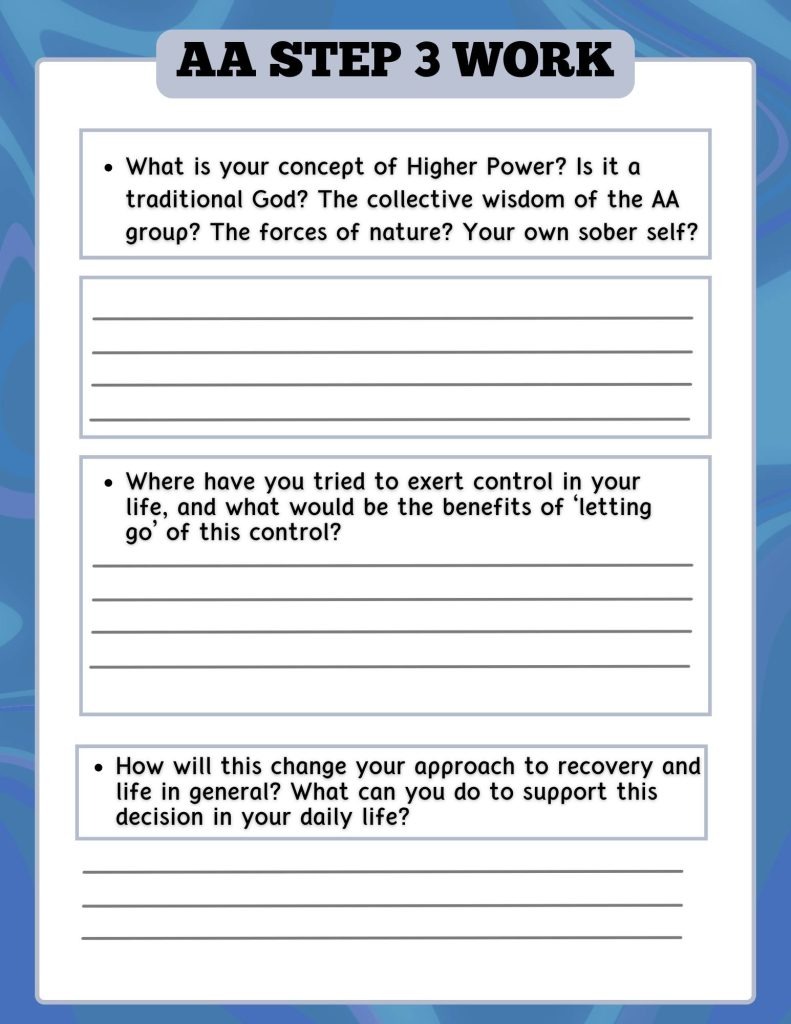AA Step Three Worksheet: A Guide
Getting Started with Step 3 and Diving Into Action
Since 1935, Alcoholics Anonymous (AA) has been a lifeline for millions of people struggling with alcoholism. At the heart of AA’s program are the 12 Steps, a set of principles to help us get sober and live a happy, sober life. Among those steps, Step 3 is a big one, a turning point in the journey.
Step 3 asks us to make a conscious decision to turn our will and lives over to the care of a higher power, as we understand it. This step is key because it bridges the gap between acknowledging our powerlessness over alcohol (Steps 1 & 2) and taking action towards recovery (Steps 4-12).
Half measures don’t work here; full commitment to spiritual growth and the 12 step process is required for real progress.
In this new SOBRLIFE resource, we’ll dive into Step 3, what it means and how to work through it with the help of our AA Step Three worksheet. Whether you’re new to AA or looking to go deeper into the program, this guide will give you valuable information and practical tools for your journey to sobriety.
What is Step 3?

Step 3 of AA says: “Made a decision to turn our will and our lives over to God as we understood Him.” This step seems simple but has many layers for those in recovery.
At its heart, the Third Step is about surrender as a path to a better life. It acknowledges that we can’t manage our addiction through willpower alone. Instead it suggests a complete 180: we turn our lives and will over to a higher power.
A decision as mentioned in the step means a conscious and deliberate choice. Not a passive acceptance but an active commitment to a new way of living. This decision sets the stage for the actions that will follow in the next steps.
Why Step 3 is Important
Step 3 is a turning point in the AA journey. It moves us from admission and acceptance (Steps 1 & 2) to action. This is important for several reasons.
Psychologically this “letting go” can be incredibly freeing. The weight of trying to control the uncontrollable is lifted and often brings a sense of relief and peace. This doesn’t mean we abdicate responsibility for our actions but rather we recognize there are forces beyond our control and learn to work with them, not against them.
In short, Step Three is about hope and trust. It’s a step away from the hopelessness and unmanageability of active addiction towards a life guided by principles bigger than ourselves.
Misconceptions about Step 3

Despite its importance in the Step-based recovery process, this one is often misunderstood by those new to AA and by outsiders. We need to clear up these misconceptions to understand this step properly.
Trying to control everything can lead to fear and stunts personal growth. We need to step out of our own way to allow for change and growth in our recovery and surrender to a higher power to find some form of spirituality in recovery. Note that this does not have to be within a formal religious practice whatsoever.
Finally, there’s a misconception that Step 3 is just about not drinking. While sobriety is part of it, the step is actually about a bigger change in how we approach life. It’s about a new way of dealing with challenges, relationships, and personal growth that goes way beyond not drinking.
Before You Start the Step 3 Worksheet
Before you start the Step 3 worksheet you need to prepare mentally, emotionally, and environmentally. This will help you get the most out of the exercise and set you up for success in your ongoing recovery work.
The Serenity Prayer can be a useful tool for this process, helps us accept our current situation and focus on making good decisions while turning our will over to a Higher Power. If you’re feeling really stressed or overwhelmed you might want to do some relaxation techniques like deep breathing or meditation before you start the worksheet.
As for materials you’ll need the worksheet itself which we’ll provide in a downloadable PDF. You might also want to have a separate journal or notebook for extra thoughts and reflections that come up during the process. Some people like to have supportive literature on hand like the AA Big Book or Twelve Steps and Twelve Traditions.
Step 3 Worksheet Guide

The Step 3 worksheet is designed to walk you through understanding, accepting, and implementing this step in your recovery. It’s divided into 4 main sections each covering a part of Step 3.
By doing this AA Step 3 worksheet you’ll find a new path in your recovery journey and learn to surrender control to a higher power.
To accompany the worksheet, we believe the Third Step Prayer can be helpful, though feel free to rephrase the God language to accommodate your own beliefs.
God, I offer myself to Thee-
To build with me
and to do with me as Thou wilt.
Relieve me of the bondage of self,
that I may better do Thy will.
Take away my difficulties,
that victory over them may bear witness
to those I would help of Thy Power,
Thy Love, and Thy Way of life.
May I do Thy will always!
Amenpg 63, the Big Book of Alcoholics Anonymous

Section 1: Your Higher Power
This section asks you to explore and define your higher power. Remember this is personal and can be interpreted in many ways. The goal is to find a power greater than yourself that can guide and support you in your recovery and in living a sober life that is fulfilling and rich.
The concept of ‘love’ as expressed in the spiritual framework of Alcoholics Anonymous can be a big part of that by helping you surrender to a higher power and align your actions with divine will.
Start by thinking about what higher power means to you. Is it a traditional God? The collective wisdom of the AA group? The forces of nature? Your own sober self? There are no right or wrong answers here.
Next, think about your relationship with this higher power. How do you communicate or connect with this power? What qualities does this power have that can support your recovery? How can turning to this power help in situations where you used to turn to alcohol?
Section 2: Areas of Control
This section helps you identify areas of your life that you’ve been trying to control, often to your own detriment. List the areas of your life where you’ve tried to control, especially in relation to your drinking. This might be relationships, work situations, others’ opinions of you, or your emotions.
For each item on your list think about the outcomes of those control attempts. How did they work out? What were the costs – to your peace of mind, your relationships, your health? This will help you see the futility of trying to control everything and the benefits of “letting go”.
Thinking about your own experience can also help you see where letting go of control could lead to personal growth and recovery.
Section 3: Practicing Surrender
Here you’ll do exercises to practice the principle of surrender in your daily life. This section includes “letting go” exercises like visualization or writing exercises. For example, you might visualize putting your worries or need for control into a balloon and releasing it into the sky.
Recognizing “thy” power in this practice will help you offer yourself to a higher power and find relief from your personal struggles.
You’ll also come up with affirmations to support your decision to turn your will and life over to your higher power. These might be statements like, “I trust in a power greater than myself to guide my recovery,” or “I choose to let go of what I cannot control.”
Section 4: The Decision
The final section of the worksheet is to solidify your commitment to Step Three. Here you’ll write your personal Step Three prayer or statement. This doesn’t have to be in any particular format – it’s a personal expression of your decision to turn your will and life over to your higher power.
Remember to use the intention of “thou wilt” in some fashion in this decision, meaning a deep reliance on a higher power to guide your actions and decisions.
You’ll also be asked to write about what this means to you. How will this change your approach to recovery and life in general? What can you do to support this decision in your daily life?
By working through these sections honestly, you’ll better understand Step Three and how to apply it to your recovery. Remember this is a personal process and your answers will be your own. Not perfection but progress.
A Few Of Our Favorite Step 3 Worksheet Tips

When working through the Step Three worksheet remember:
First and foremost honesty is key. The worksheet is a tool for self-discovery and growth and its value is in your willingness to be honest with yourself. You don’t have to share your answers with anyone else if you don’t want to but being honest in your personal reflection is necessary for progress in your recovery.
Take your time with each section. This isn’t a sprint and there’s no prize for finishing first. Some parts of the worksheet may be hard or bring up emotions. It’s okay to take a break if you need to or spend several days working through the whole worksheet.
The goal is thorough self-examination and understanding, not speed. Done properly this work will prove the power of spirituality in recovery.
If you get stuck or struggle with a section don’t hesitate to get support. This might mean talking to your sponsor, sharing in an AA meeting, or talking to a trusted friend in recovery. Sometimes hearing others’ experiences with Step Three can give you valuable insight or a new perspective.
Finally, remember this is a personal process. Your answers and experiences will be your own. There’s no right or wrong way to do the worksheet as long as you’re being honest and putting in the effort.
After the Worksheet (Add 3rd step prayer)
One way to support your Step Three work is to review your worksheet regularly, weekly to start, and then monthly as you get more comfortable with the principles. This will help you stay connected to your decision to turn your will and life over to your higher power.
Share your worksheet with your AA group or sponsor. This will not only support your own commitment but also help others who are working on this step.
Step Three isn’t about being perfect in surrender. You’ll likely find yourself trying to take back control. When that happens just remind yourself of your Step Three commitment and recommit to turning it over to your higher power.
As you continue on your recovery journey the lessons of Step Three will apply. The willingness to surrender and trust in a higher power will serve you well as you do your personal inventory in Step Four, make amends in Steps Eight and Nine, and work on your spiritual condition in Steps Ten, Eleven, and Twelve.
Turn to SOBRLIFE for the Latest Recovery Content
We hope that at this point you can confidently say, along with a sponsor, that you have completed Step Three! Be proud of yourself and know this is a major accomplishment in the path to staying clean and sober.
Having done the Steps, or otherwise achieving sobriety that is stable and rewarding, we hope you will join us at SOBRLIFE in embracing the ‘recover out loud’ movement! We seek to show the world our strength and resilience, and that recovering people are everywhere, in order to make it clear that there is hope for those still struggling with active addictions.
Keep an eye on SOBRLIFE.com for the latest in resources related to recovery, and for fresh and clean styles and our new SOBR WATER, all ways to show you are proud to live the sober life!
